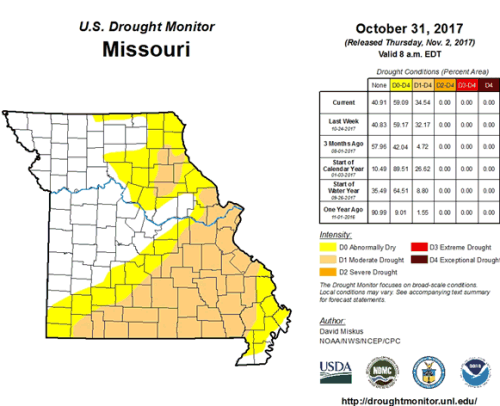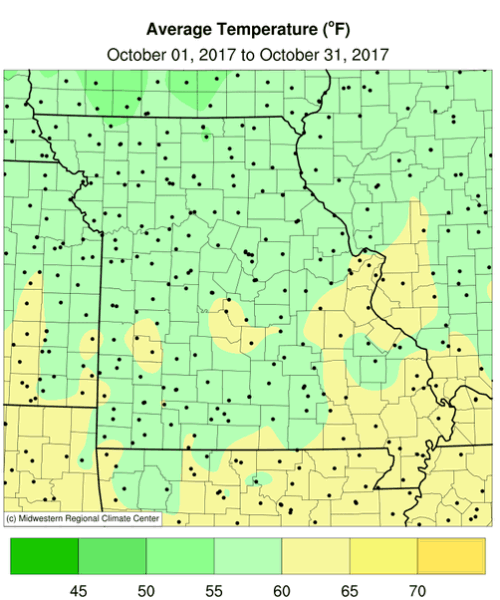
October 2017 Weather and Its Impacts on Missouri
Pat Guinan
State Climatologist
Commercial Agriculture/University of Missouri Extension
Anomalous autumn warmth persisted through much of October with temperatures averaging 5-7 degrees above normal for the first 3 weeks of the month. A pattern change, during the last week of October, resulted in cooler Canadian air masses moving into the region and below normal temperatures. The growing season came to an end when widespread freezing temperatures impacted much of the state on October 28-29. Median spring and autumn dates for specific freeze thresholds in Missouri can be found at http://ipm.missouri.edu/FrostFreezeGuide.
Preliminary October temperature data indicate a statewide average temperature of 59°F, or 2 degrees above the long-term average. It was the 8th time in 2017 where a month was warmer than average, Figure 1, and the 4th consecutive warmer than average October, Figure 2.
A wetter pattern emerged after a dry September, especially across northern, west central and central sections. Dry conditions continued to impact east central, south central and southeastern Missouri, where moderate drought persisted at the end of October, Figure 3. Preliminary rainfall data indicate an average statewide October total of 4.00 inches, or 0.79 inches above the long-term average. It was the fifth month in 2017 with wetter than average conditions, Figure 4, and wettest October since 2014, Figure 5.
According to the NOAA NWS radar analysis map for October, Figure 6, rainfall estimates were lowest in south central and southeastern Missouri, especially over portions of Oregon, Carter and Ripley Counties, where 0.50-1.00” were estimated to have fallen. Highest monthly totals occurred over pockets of northern, central and west central Missouri where 6-8 inches were estimated.
The mild Sep-Oct period, in combination with wetter October conditions, translated to a rejuvenation of warm season grasses over parts of the state. Autumn colors were slow to emerge and leaves remained intact on most shrubs and trees at the end of October.
The dry conditions across south central Missouri translated to on the ground impacts, especially for livestock producers. The following are excerpts of impact reports from experts in the region:
Ted Probert, Extension Dairy Specialist, Wright County, Mountain Grove, Missouri November 7, 2017
“There are a lot of ponds drying up making livestock water a concern. Fall growth of pasture has been curtailed and a lot of people are starting to feed hay early. The good thing is that there is quite a bit of hay in the area. Another issue is the failure of a lot of fall sown crops to germinate or at least to do so in a timely manner. A lot of the annuals such as oats, turnips, etc. have not produced well. Also fall seeded perennials in some cases germinated then died or didn’t germinate until mid to late October, leaving them pretty immature going into the winter. It was drier than this in 2012 but that was earlier in the year. We had some fall rain that year. This may be the driest fall I’ve seen. We had almost no rain September – maybe a tenth or two.”
Jamie Gundel, Agronomy Specialist, Oregon County, Alton, Missouri
November 7, 2017
“I would say we were definitely in a severe drought in south central Missouri. I have had several producers with ponds that went dry and most livestock producers have been feeding hay for at least 2 months as many pastures have no forage available. I have talked with a lot of producers and most agree that this year is as bad if not worse than the drought of 2012.”
Ted Cunningham, Livestock Specialist, Dent County, Salem, Missouri
November 7, 2017
“I’d say the greater Dent County area, especially from Hwy 32 and south, and Hwy 68 and east is in a severe drought. Some areas north towards Rolla have received a bit more moisture this fall but spotty at best. Many areas have had 2 inches or less since early/mid August, with the majority of that rain coming in the last couple weeks which was too late for good grass growth. I’d estimate fall (September/October) pasture growth to be 25% of normal. Many producers fed some hay earlier hoping it would rain to grow stockpile, others are currently feeding some cattle and the majority will be feeding considerably earlier than normal. Hay demand is pretty strong, but I think supply is still decent, mostly from a large carryover of hay from last year/winter. Probably the biggest immediate concern is pond water, with many folks I’ve talked to reporting ponds lower and in worse shape than in 2012. 2012 was the last time I saw it this dry, which of course we were terribly dry that year through the summer, but had an incredibly good fall. This year, it’s the worst fall I’ve seen for pasture/stockpile growth, and I’ve been here since 2003.”
According to the Missouri Agricultural Statistics Service, for the week ending October 29, corn and soybean harvest was 80% and 63% complete, respectively; 1 percentage point behind the 5-year average for corn and 3 percentage points behind for soybean. The majority of topsoil and subsoil moisture conditions were reported adequate at 73% and 68%, respectively. Hay supplies and stock water supplies were also mostly adequate at 79% and 81%, respectively.
Regionally, the worst stock water supplies and soil moisture conditions came from the south central crop reporting district (CRD 5), where stock water supplies were reported 38% short and 21% very short. Topsoil moisture was 47% short, 22% very short; subsoil moisture was 53% short and 21% very short.
Jump to:

Figure 1.

Figure 2.

Figure 3.

Figure 4.

Figure 5.

Figure 6.




Source: Pat Guinan, 573-882-5908












